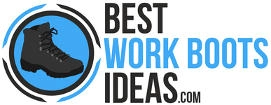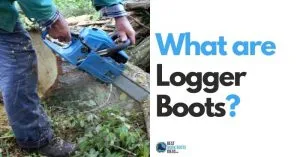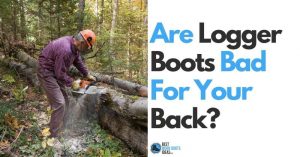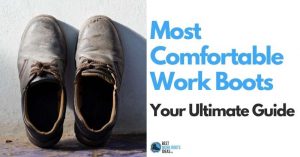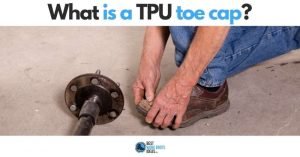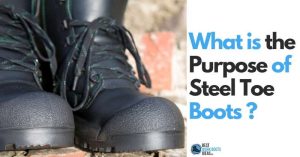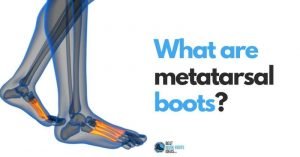Protect Your Physical Health With the How and Why: Can Steel Toe Boots Cause Foot Problems?
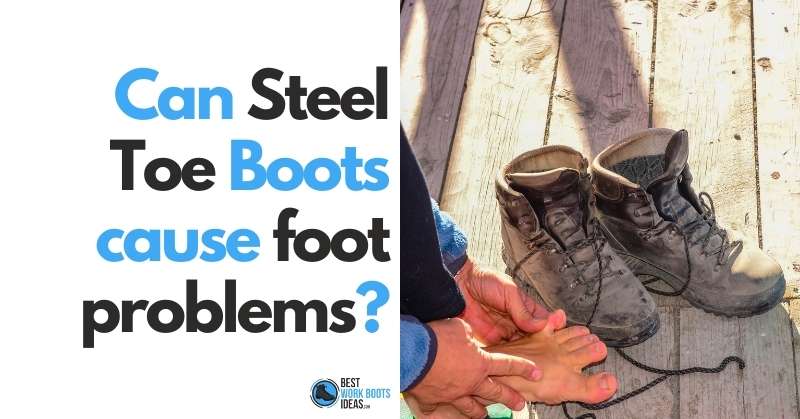
Yes, steel toe boots can cause foot problems. That said, it’s misleading to suggest that a steel toe cap alone can cause damage to your foot. There are a number of harmful situations that could occur as a result of wearing improperly fitted steel toe boots, as many people do.
Today I’m going to talk about the problems that can occur from wearing steel toe boots and the reasons they occur.
Contents
How Do Steel Toe Boots Cause Foot Problems?
Steel toe footwear has a reputation for a firm, inflexible fit that causes pain for toes, the arch, and other areas of the foot.
This pain is created by inflexibility in these areas that translates into chronic pain in the corresponding areas of your foot.
A continuous, low level stress on the foot will gradually expand to other areas of the body.
Whether we want to acknowledge this or not is irrelevant, but stress on the foot will become stress on the ankle as it tries to compensate for the pain.
This can then jump to the knees, calves, or even further up the body to the back.
In the Toes
Steel toe caps limit the range of movement for the toes, creating quiet but steady tension in the foot and ankle with each use.
If you’re scoffing at that, do an experiment. Take your shoe off, and compress your toes just a little bit towards your big toe. You’ll feel a little muscle response to this throughout your foot to the top of your ankle.
It doesn’t hurt for a minute, or even an hour, but over days and weeks, it can definitely cause problems in muscles and tendons.
In the worst cases, the skeletal structure of the toes changes to accommodate the fit of the toe cap.
In the Arch
The rigidity of the arch in some steel toe boots can end up causing pain when fit for the wrong person.
While the presence of a firm arch reinforced with a steel shank can be exactly what’s needed for linemen and loggers, for others it’s way too much.
Sometimes this can be altered by getting different footbeds (insoles, Dr. Scholls, etc) that put less pressure on your arches, but often it just requires finding a different pair of boots.
In the Heel
The heel of a steel toe boot is often raised above the ball of the foot, causing changes to posture and stance.
This results in changes in tension to the tendons and muscles that work around your feet and ankles, sometimes resulting in strains and sprains.
In addition to how raised heels can alter gait, sometimes the actual space allotted for our heel to rest is too small.
Like with toes, boots that are too small to properly support your heels won’t hurt much at first, but over time it’s an added strain that can cause cascading problems.
What Kind of Common Foot Problems Do Steel Toe Boots Cause?
- Bunions
- Hammertoes
- Morton’s Neuroma
- Plantar Fasciitis
- Heel Spurs
- Sore feet
There are a number of nerve, tendon, and bone problems caused by the rigid and sometimes inadequate fit of many steel toe boots.
It’s not fair to blame solely the steel toe, and it’s more accurate to say that many steel toe boots have a bad fit.
There are medical problems that result from wearing the wrong size shoe, no matter the type of shoe, so it’s not fair to blame these problems specifically on steel toe footwear.
That said, it’s always a good reminder what you’re avoiding when you get boots that really fit.
Bunions
Bone shift exacerbated by poorly fitted shoes over a long period of time. The end toes on either side shift their position to accommodate some external force (often footwear).
This is exactly what the zero drop community is pointing out is wrong with many shoe styles we use.
Hammertoe
Bone shift in the toes where the joint will protrude upwards as to reduce the length of the toe.
It’s like a bunion going up instead of out.
Morton’s Neuroma
A nerve condition caused by the same conditions that cause bunions and hammer toe.
The top of the foot near the third and fourth toe can become numb or give the sensation of a pebble being in the shoe when none exists.
Plantar Fasciitis
Inflamed tendons resulting from the firm cradle of the arch and heel often found in steel toe boots.
Heel Spurs
Long term result of poorly fitted heels in which new bone begins to grow off the existing heel, usually as a response to discomfort.
This is the body literally growing fresh bone to offset the discomfort it’s experiencing as a result of a heel that’s pinching instead of cradling your foot
Why Do We Wear Boots That Don’t Fit
Any boot with a toe cap has a finite amount of space for the toes to move, that’s obvious.
What’s not obvious is that many people are wearing the wrong size steel toe boots.
That’s right, a lot of us don’t even know our shoe size (and I include myself in this).
The truth is, many of us walk into a store (or online) and select whatever we think our shoe size is without really examining any recent data.
We ask for an 11.5, try it on, and however it feels, we buy it.
We consider the features, the brand, the style, the price, but often don’t consider the fit might be bad.
Sometimes a brand makes a style that just doesn’t fit our feet. But it’s my favorite brand!
Doesn’t matter.
But I’ve always worn Brand X!
Doesn’t matter.
It happens all the time that brands we like change some feature of a product that had worked for our needs. It happens before our eyes with cars from year to year, and the same happens for boots.
The Timberlands of today aren’t the ones you bought in 1999, nor of 2009; products change!
It’s because of this that many people end up getting boots “in their size” for years without ever re-evaluating what their size is.
There’s also those who have grown to accept a heel that pinches or a toe cap that crunches their toes together as part of the experience of wearing protective boots.
Some people just assume there’s required discomfort that there truly isn’t.
Not trying to start a problem, but there’s a decent chance you don’t even know what a good fit is.
Anyone who’s married can tell you, there’s often times that you’re certain you’re right, only to discover later that your spouse’s idea or suggestion was 100% correct.
Same could apply to your boot size.
This can happen with the gear we wear too, where we’re just caught up in some false machismo of “work’s supposed to hurt” instead of just taking an hour to try a couple different pairs.
To find out which actually feel the best
That said, there are issues caused by steel toe boots, just not always related to the product itself as much as how we choose to use it.
Do Steel Toe Boots Damage Any Other Parts of the Body?
Steel boots can cause issues all the way up into the back, but it’s hard to conclusively determine this.
It’s fair to say that wearing boots that are substantially heavier and bulkier than regular shoes or bare feet are likely to cause some impact.
How Do Steel Toe Boots Harm the Body?
Added Weight
Steel toe boots’ weight and awkwardness can interfere with the natural mechanics of the body and cause a number of issues.
Natural stride and the ability to navigate one’s own feet can both be changed by a pair of steel toe boots, causing various joints to compensate for the awkwardness
A good study was done that detailed the complaints of workers wearing steel toe work boots and the second largest complaint was their weight.
You might also be interested to know how much steel toe boots weigh. Its quite a common question and one we have answered in a separate article.
Pushing Stance Forward (Tall Heel)
We have a much more thorough discussion on this topic in our article on zero drop footwear
Can My Toes be Cut Off Wearing Steel Toes?
Its a perfectly valid question and one which we answer here.
Alternatives to Steel Toe That Bypass the Problems Caused by it
Composite Safety Toe
Boots with a composite toe cap are an excellent alternative to steel that provides ASTM-rated protection without the excess weight of steel.
Composite toes are made with modern materials like TPU, carbon fiber, and fiberglass that don’t require steel’s density to prevent your toes from being crushed or cracked.
Besides being lighter, many composite toe caps take up less room in the toe box, giving your feet more room to move.
This helps alleviate pain to your feet and ankles that can develop from repeatedly jamming your toes in an area not big enough for them to relax.
Soft Toe
Grabbing a soft toe boot is an even lighter alternative, but isn’t possible for everyone.
Many workers are required to wear safety-toe footwear on the job, and many others just want to know their toes are protected on the job.
If you’re working on large sites where OSHA requirements need to be followed, absolutely don’t go soft toe.
You could get hurt, in trouble, get your employer in trouble, and really make a bad situation where one wasn’t needed.
I am one of those trade workers who used soft toe shoes because my job didn’t prevent it.
In residential construction, I was rarely holding anything heavier than lumber, and there was never any heavy machinery rolling past me in someone’s kitchen so I felt safe to make this choice.
My Two Cents on This…
It’s easy to point the finger at a particular style or product as being the problem, but it’s too simplistic.
I don’t think there’s anything wrong with steel toe boots, I think it’s often that we’re just getting the wrong size, and angry at the wrong thing afterwards.
It’s better to always aim get the right fitting work boot first. Having the correct protective footwear can help to reduce any foot injuries later.
